
Photo Timothy Schenck/©Charles Gaines
Editor’s Note: This opening essay originally appeared in Reframed, the Art in America newsletter about about art that surprises us, about the works that get us worked up. Sign up here to receive it every Thursday.
Like most cities anywhere in the world, New York is rich with history. In certain areas, that history feels almost palpable, especially in a city where so much has been lost or otherwise purposefully—and violently—erased, ignored, and hidden. One aspect of New York’s past that met such a fate is how the city’s economy was built on chattel slavery. Drawing out that history and thinking about it critically is the crux of Charles Gaines’s Moving Chains, a monumental 110-foot installation that comprises a wooden structure that resembles the hull of a ship, with nine sizable chains overhead.
From its site on Governors Island, Moving Chains, which had its closing ceremony this past weekend (and which will travel to the banks of the Ohio River in Cincinnati next year), was located at a locus point for different histories. It looked out to Lower Manhattan, the unceded territories of the Lenape people that would be seized first by the Dutch to create their settlement, New Amsterdam, and later taken by the British to create New York. There was a slave market on Wall Street, and even after the abolition of slavery in New York in 1827, Wall Street still played an important role in the transformation of cotton into wealth. That the East River and the Hudson River meet just off Governors Island is also significant: the docks on the East River imported sugar from the Caribbean, while the Hudson connected the Eastern Seaboard with the interior of the US upon the completion of the Erie Canal in 1825.
But the view from Governors Island also represents hope with its proximity to the Statue of Liberty, which was given as a gift to the US to celebrate the final abolition of chattel slavery at the end of the Civil War. The most direct reference to this in the statue are the chains at Lady Liberty’s feet—chains that had once held her in bondage. Over the years, that history, too, has been slowly eroded, with the Statue of Liberty coming to represent the promise of freedom for immigrants arriving from Europe.
These facts and more are elucidated in a walking tour, titled River Years, made by Black Gotham Experience to accompany Moving Chains. The tour, which remains accessible on Creative Time’s website, gives a poetic and poignant telling of these stories, asking listeners to consider the ground they are on, the powerful force of the water roiling before them, and the histories of sites that can easily be forgotten or misremembered. “It’s meant to be more meditative, with pauses and considerations, versus a 25-minute Wikipedia firing hose,” Black Gotham Experience founder Kamau Ware told a group assembled for a live demonstration of River Years this past (very rainy) Sunday.
What I found most powerful about experiencing River Years and Moving Chains together, as the rain misted my face, was reflecting on the sound that the rivers made as they crashed against the rocks. As Ware pointed out, a large portion of Governors Island’s 172 acres were created with landfill. As we turned a bend around Castle Williams, with Moving Chains looming in the distance, we began walking on such an infilled portion. In the audio tour, Ware’s voice asks us to listen to how much louder the crashing sounds of the waves have become. “What if 1,000 human years equaled one river year?” he wonders about waters that have been around much longer than any human. The waters know their place—and they will stop at nothing to reclaim that history, no matter how slowly.
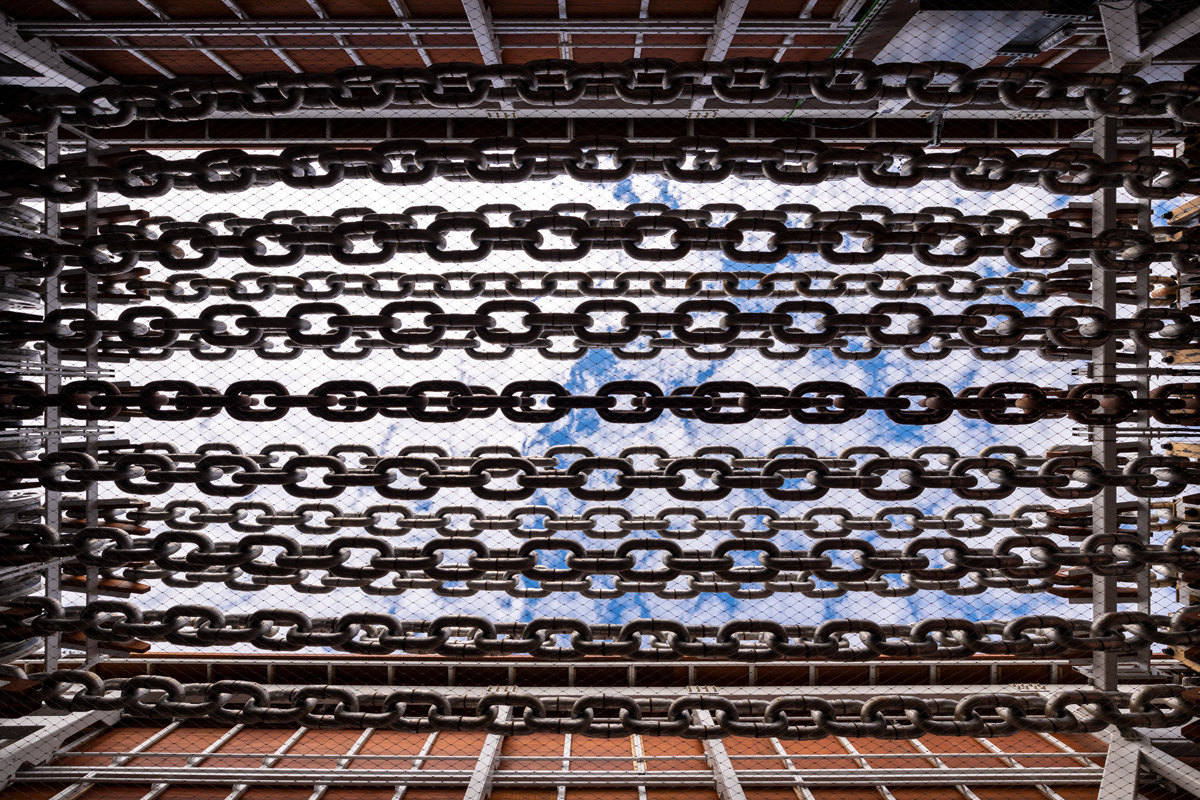
Charles Gaines: Moving Chains (detail), 2022.
Photo Timothy Schenck/©Charles Gaines
This interview, conducted in August 2022, has been edited and condensed for clarity.
A.i.A.: How did your multipart work, The American Manifest, which the Governors Island installation Moving Chains is a part of, come together?
Charles Gaines: The project really started over eight years ago. I was asked to make a proposal for public commission for St. Louis, Missouri. They were at the time expanding their park grounds. They brought Creative Time to be the curator of the public art project. To my shock and surprise, they selected my piece. I went out to St. Louis and visited sites. At the time, director of Creative Time was Anne Pasternak, who is now director of the Brooklyn Museum. Working for her at the time as a curator was Meredith Johnson. And later, Jean Cooney joined the project. And Justine Ludwig, who is now the current director of Creative Time.
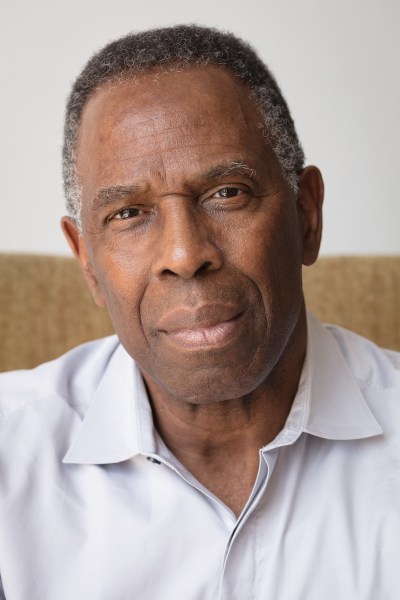
Charles Gaines.
Photo Fredrik Nilsen/Courtesy the artist and Hauser & Wirth
When I went out there and was looking at the site, realizing the history of the site, I came up with a project around the subject of Dred Scott. Three things at the site were notable to me. One, of course, was the Mississippi River. I should say that I didn’t go in with an intention of creating such a quietly political piece, but being there, the history of the region is so prominent. That history is framed by some pretty provocative subjects, which are memorialized there, like at the St. Louis courthouse, where the Dred Scott trials took place. And the Mississippi River was fundamental in terms of the development of agrarian capitalism—and essentially, in general, the American economy came out of that. The St. Louis Arch helped introduce the ideology of Manifest Destiny, positioning St. Louis as the gateway to the West. And to the west of St. Louis, at the time, were “unconquered” lands, so to speak.
So, I thought the centerpiece of this could be the Dred Scott case. The history of slavery becomes essential. Within the educational system in the US, the development of America and its relationship to capitalism is connected with democracy, but in a way that makes sure that our understanding of economic development was a noble enterprise—part of this general idea of progress, with America taking a lead position. But, it was not connected with the slavery, and neither was that idea of capitalism. Even though it’s so obvious, it could slap you in the face. American imperialism is taught still as a noble enterprise because it’s bringing “enlightenment” to the world, so to speak. But it was separated from the part of capitalism that deals with the idea of property. To connect them might suggest that this noble enterprise is really being driven by greed.
So, I wanted to design a piece that would try to integrate these narratives. That I would not only be doing a critique of American capitalism and American economic development but also America’s investment in slavery and a critique of Manifest Destiny and imperialism, introducing quite provocative critiques that have been obscured in the education that I got. So, Moving Chains became the lead structure in that effort to address these narratives.
I proposed that piece. Creative Time was very excited about it. We took it to St. Louis; they were very excited about it. But for some reason, St. Louis’s idea of community development collapsed, and so the whole project fell apart. This was between six and eight years ago.
How did the project resume in its current manifestation?
I have to give credit to Creative Time, because they would not let the project die. They kept in communication with me, trying to find new sites, new possibilities, and new sources of funding. There was one point when we evaluated sites [in Manhattan]. That brings up another important element, this piece is site-specific. The objects are so dependent upon the history of sites, to have resonance. It had to be located in particular sites where that history is part of the development.
When Justine [Ludwig] was hired, the project was sitting on the shelf because it had been dormant. She really loved it, and she called me and asked me if I would mind taking it up again. She started the campaign—it’s an almost $4 million project. Almost simultaneously, Jean [Cooney] took on the job as the head of Times Square Arts and Meredith [Johnson] took on the job as the head of art for the Trust for Governors Island. And they asked me to come up with a proposal for a separate project. So somehow, because I didn’t tell them, [Meredith and Jean] found out about Justine’s interest in Moving Chains, and Justine found out that they were doing a project with me. So, they all got together, and came up with the idea of collaborating around reviving Moving Chains, and that’s how it came back into being.

Charles Gaines: Roots, 2022, installation view in Times Square.
Photo Michael Hull/©Charles Gaines
How do the other chapters of The American Manifest, including the installation in Times Square and the planned travel of the work to Cincinnati, relate to Moving Chains?
When Meredith, Jean, and Justine got together to collaborate, they were each thinking about how they could uniquely contribute to the project. They wanted to think through the collaboration that way, rather than it just being a singular work and putting it up in one place. They wanted to use the fact that there was a larger group to make the project bigger—not only physically, but give it a bigger, critical presence. At some point, we had to think about it more than just Moving Chains, and we had to think of a title about what the project is proposing as a critique. To come up with a concept for the project based around this critique of these three integrated narratives: this critique of American culture, particularly with how these aspects of American culture have been dealt with today. With that mind, we came up with the idea of siting the “Manifestos” in Times Square. There are some technical problems with trying to do a physical manifestation of “Manifestos” in Times Square, so Jean asked if I could come up with another idea for a site work. That’s how the installation Roots [sculptures depicting upside-down trees in Times Square during July–September 2022] came to be. We also decided that the best place for the Moving Chains structure was Governors Island because it had all of the requirements in terms of site location, that I was talking about earlier.
And then Cincinnati [where The American Manifest will travel in 2024] came into picture because Justine, who had worked in Cincinnati for years [as a curator at the Contemporary Arts Center], suggested it. I’m trying to create a structure where these individual sites are employed to showcase the contributors to the project. Cincinnati is almost identical to St. Louis in terms of the history of the role the city played not only in the narrative of slavery but also in the narrative of economic development.
One of the things that I wanted to do in integrating these separate narratives was to include the history of the Native population in terms of this idea of American expansion. St. Louis and Cincinnati were created by removing the Native population from their lands, and that excavation and removal helped with this critique that I am trying to do. If we can’t go to St. Louis, let’s go to Cincinnati.
From that, we came up with the idea to divide the presentation into parts. The first metaphor was a fugue in three parts, a musical metaphor. But, then we got into a literary and historical model by calling them chapters. So, we can reveal this whole project in chapters: Chapter One in Times Square, Chapter Two on Governors Island, and Chapter Three in Cincinnati. And that also helped with the complexity of fabrication and construction.
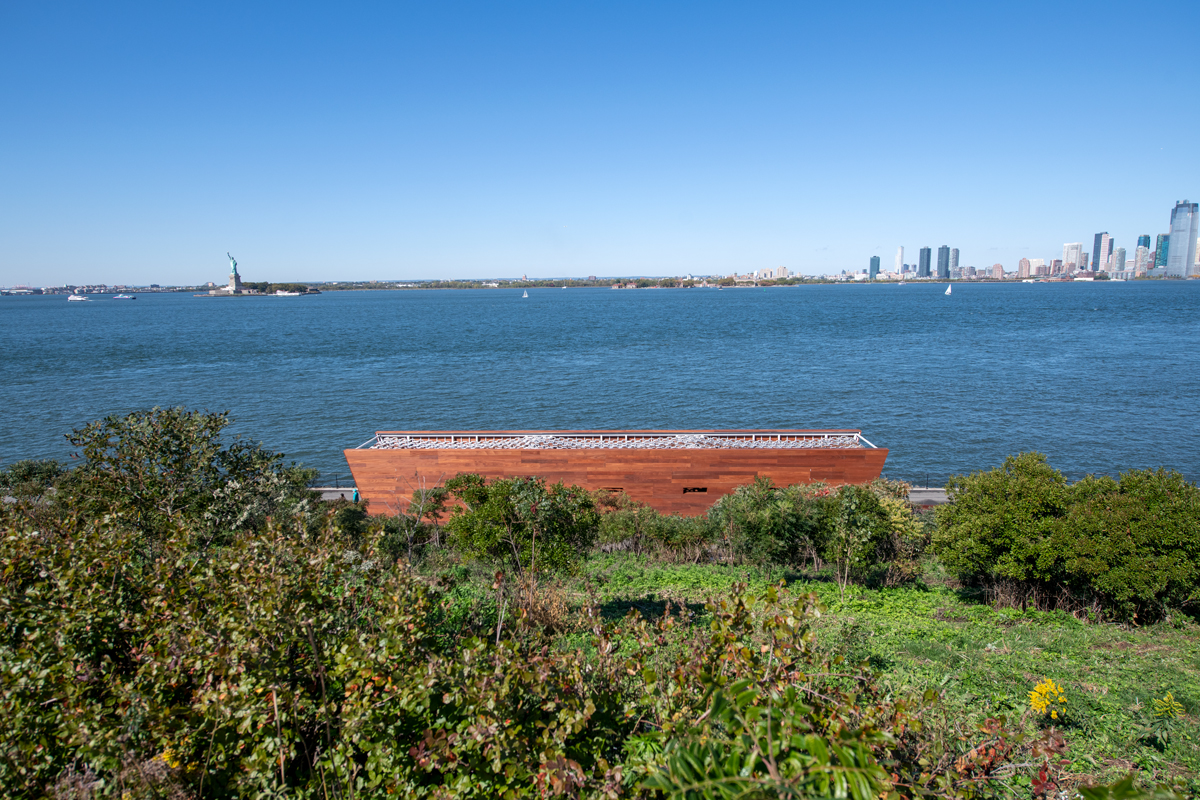
Charles Gaines: Moving Chains, 2022.
Photo Timothy Schenck/©Charles Gaines
How did the proposal change from the original St. Louis one?
In St. Louis, we were going to the courthouse [as a backdrop]. The courthouse was going to be used as the site of the “Manifestos” performance. Manifestos 4 is a piece where I take the text of the majority and minority opinions in the Dred Scott Supreme Court decision, and I convert the opinions into musical notation and write a score for an ensemble. The way I do that becomes important because the whole process is systematically determined, so that the music is translated via a set of rules of transforming letters into notes. The product of that process was to be installed in the courthouse. We were also planning a one-act opera that would be performed in one of the courtrooms. This is a mutable process. It wasn’t a matter of being disappointed when something couldn’t be done because we came up with something else that could be done.
When you read both opinions in the Dred Scott case, they are written rigorously, under the rules of legal language. There’s certain logic that they have to maintain in order to sustain a certain legitimacy. And when you read it, what they are saying is nonsense. I think in the 19th-century, it even appeared to a lot of people as nonsense. The use of language is being motivated by feelings, so if you’re anti-slavery, then you’re going to find a legal way to justify that. More often than not, that language makes no sense in relation to lived experience.
Was the concept for Moving Chains always a monumental sculptural work that resembles the hull of a ship with chains?
The only thing that changed was that in my original version the structure was 400 feet long. [Laughs.]
The intention was to show that the United States has never come to grips with its real investment in slavery—it still hasn’t. But neither American democracy nor American capitalism has ever divested itself from a general idea of Enlightenment and how Enlightenment theory has provided a model of a humanist concern for the development of wealth and the development of capitalism. There was a so much religious fervor about that desire. The United States wanted to advance itself as being motivated for the general public good in the development of these areas. This explains why America is not interested in revealing the true history of slavery because it would dismantle and reveal this myth they had about being invested in the general good. These narratives are kept separate because if they were thought to be in harmony or in sync with each other they would reveal that what is essential to American development is violence. The violence that was part of the American development has been washed away, just like slavery, or the violence has been rewritten in terms of the good guy/bad guy, humanist interest in good. In this work, I wanted to make sure that people could understand the relationship between these narratives, although separated, are actually linked together and inseparable, and, simply by doing that, to reveal those uncomfortable stories.

Charles Gaines: Moving Chains, 2022.
Photo Timothy Schenck/©Charles Gaines
A lot of my work deals with the political subjects, but my interest in art is that art has to take part and contribute to the general understanding. That doesn’t necessarily mean that art has to have specific political ideas that drives it, although it could. In relationship to this piece, it is important to me, and this goes back to history of my work, that Moving Chains reveal the link in these relationships, and the reveal is done by the exposure of certain conceptual and linguistic structures that not only can explain why they were separated in the first place but also reveal why they’re linked. This is why I work in systems because I’m working on this structural level—or syntactical level in terms of language—whereby you can see how meaning is formed, and how then the formation of those meanings can take on very specific political interests.
The reason slavery and capital development are separated is because by seeing the treatment of slaves and the treatment of pigs, horses, and corn that would reveal how slavery was justified. But it would also reveal this real, serious level of violence. In other words, the commodification of the Earth and the commodification of human beings are both violent acts. They have violent consequences. The building of agrarian society doesn’t have to be done through a certain kind of laissez-faire economics. There are different kinds of economies that you can develop. But the ideological principles that govern American capitalism reside in and can be seen clearly in the way America dealt with slavery, so you can see how unique it is. The link and relationship between these parts I tried to make [visible] by showing structural resemblances between them.
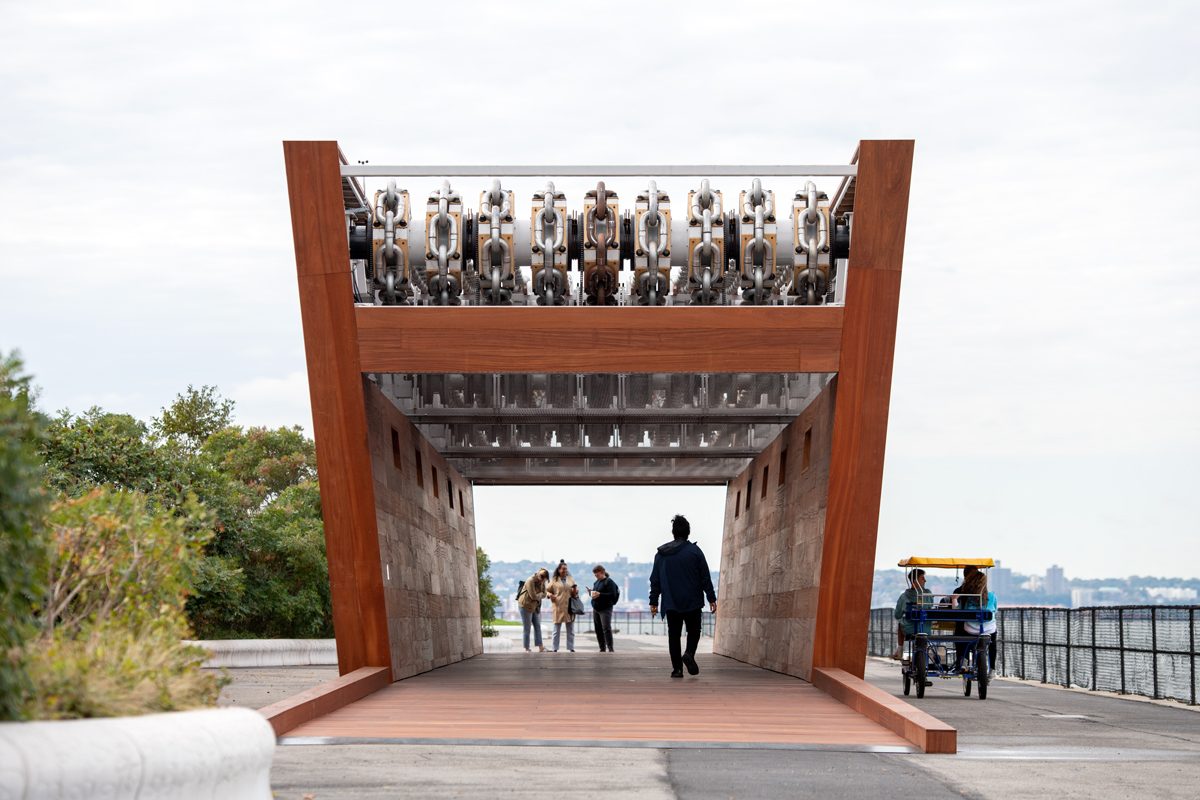
Charles Gaines: Moving Chains, 2022.
Photo Timothy Schenck/©Charles Gaines
I want Moving Chains to refer to more than one thing. I don’t want it to just refer to slavery; I want it also to refer to economic development. There is a system of signifiers that can link the two because of redundancies and similarities that can be seen between the narratives. For example, the chains themselves, both metaphorically and metonymically, bring up the narratives of slavery and trade. Chains are something that are a part of maritime life, used for hauling, lifting, and anchoring. But they’re also used for bondage.
In the structure, there are nine of these chains. Eight of them are aluminum, and one is a kind of rusted red. The silver chains move at the current of the river, and the red one moves at the speed of the vessels that traverse the rivers, moving trade around. We actually had to reduce those speeds because rivers move at 2.2 knots, and the speed of vessels are like 4.5– 4.7 knots. When you walk into it, you enter a really kind of intimidating space where these chains are above your head, and you can see them and you can hear them. They make this sound of what it sounds like to be in the hull of a wooden ship. But it also feels like you’re in the hull of a slave ship. So through analogy, we’ve tried to link these separate narratives, which is the personal intention that I have in the formal critique of this work.
Would you say that’s the system that has created the work?
That’s such a super question. My investment in art is to make a rule-based process to substitute my subjectivity being the driving factor. In the “Grid” works, you could see how the system works. It’s just a plotting and mapping system. But in the language pieces, it’s a little bit more mysterious. I don’t think it’s abstract. When we think of systems, we think of numbers. But we don’t think of systems when we think of structures. Structures are systems—it’s embedded in the word. What I’m using is language. So, the issue is that I’m not saying, “Here are some chains, and it creates this horrible experience, and that’s a critique of slavery.” What I’m saying is I can contribute to our general knowledge about the United States treats these narratives and how to reveal obscured parts of these narratives, simply by articulating through metaphors and metonyms. I don’t do anything directly. The chain is not a chain that you use for hauling or lifting or bondage. The chains become this tool for metaphor and metonym. By revealing the underlying structure of any cultural construction—a concept or an idea—by revealing how it’s constituted structurally or linguistically. In the linguistic mapping, you can make analogies. And that allows you, then, to link things that are otherwise separated. What I’m saying is that I didn’t make a slave ship—I made a structure, even if it looks like a ship.
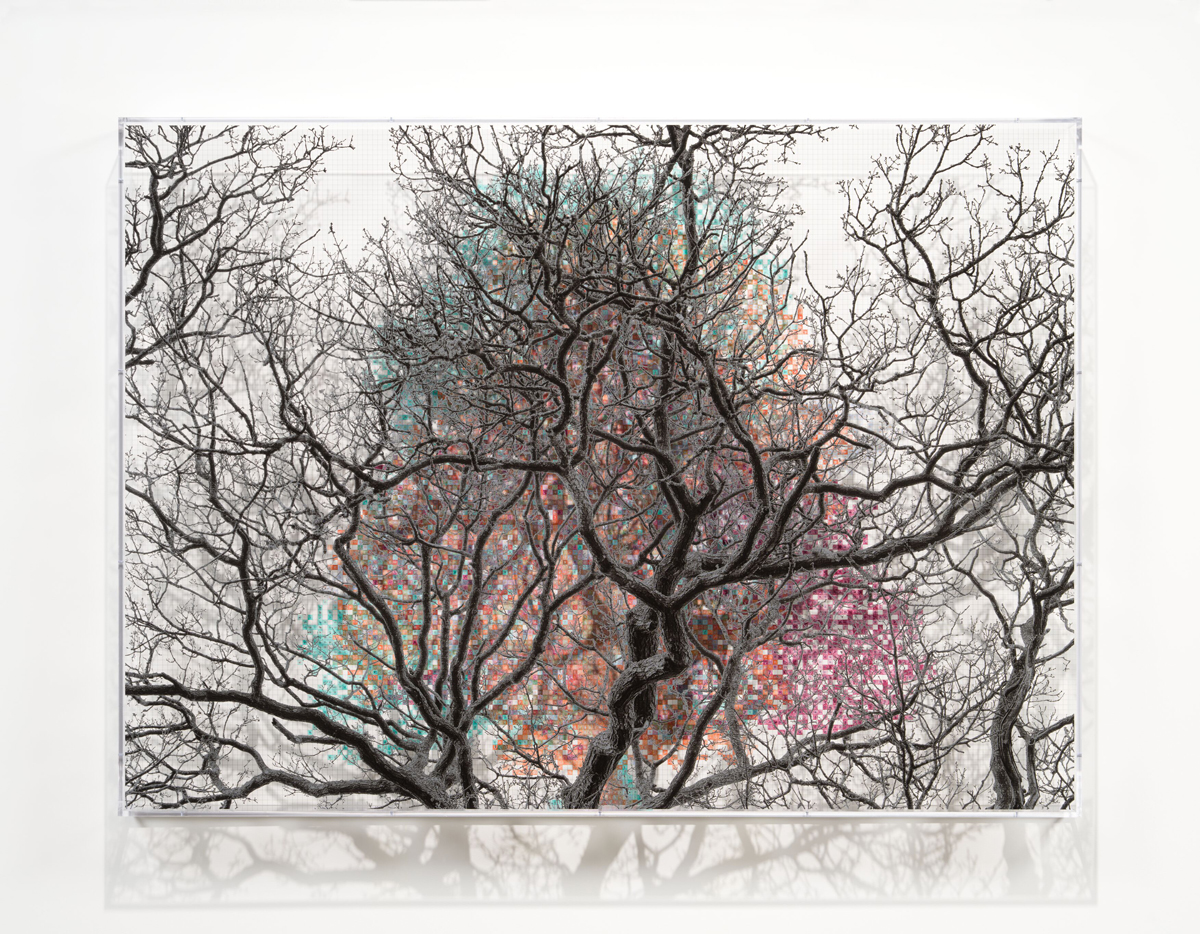
Charles Gaines: Numbers and Trees: London Series 2, Tree #4, Millennium Bridge, 2022.
Photo Fredrik Nilsen/©Charles Gaines/Courtesy the artist and Hauser & Wirth
Can you say more about how the “Grid” works and Moving Chains are conceptually related?
They’re related because they’re both systems. It’s interesting because the “Grid” works, there’s nothing mysterious about them. They can be easily perceived, but they run into this problem with people’s fear of numbers and systems. They think there’s a secret, hidden meaning. People are always going after meaning, which is great because I want them to go after meaning. But, they think that their ability to understand is made complicated by the fact that it’s high math. I mean, it’s this phobia. Some of the most sophisticated things I know have yelled at me for that reason. The only way I can rationalize it is that there’s still this process going on in art, particularly in the disrespectful way first- and second-generation Conceptualism is being treated by history. There is this attempt to erase Conceptualism out of the historical narrative because people think that Conceptual art is boring. That’s because it deals with words, and it deals with numbers, and it can have this sort of anti-aesthetic property. So, when they see numbers, they think it’s there not to give access to those experiences, but to obscure, to cloud itself, or to embrace boredom as an empowering gesture. It drives me nuts. Just as the United States, in general, has not come to terms with history of slavery, art hasn’t come to terms with its uncritical embrace of aesthetics.
I have an interest in my practice in critiquing representation. Through my critique of representation, I wanted to critique the idea of aesthetics. What I wanted to do was show how aesthetics rather than the modernist idea that the aesthetic experience is an experience that’s not informed by our cultural knowledge and that it’s universal. Rather than say that, I wanted to say that aesthetics is culturally determined. The feeling that we call an aesthetic feeling is culturally determined, and it’s also politically determined. As you watch how tastes change over time, I don’t know how you can avoid that.
What we critique are ideas. When you do a math problem, for example, you’re not involved in the critique. It’s just a tool. So, the making of my work is supposed to be like that—it’s playing out a math problem. Because of something that I do, you begin to question what it means to you, then that’s where the critique can happen.
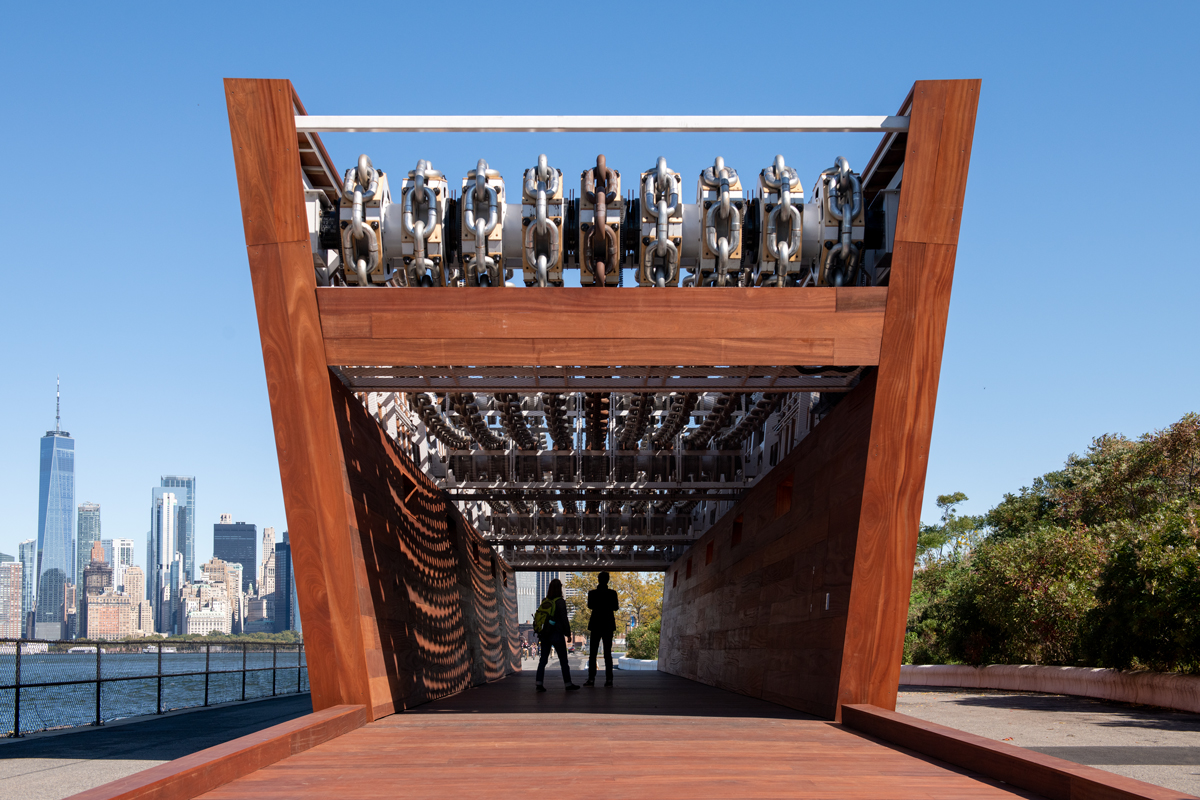
Charles Gaines: Moving Chains, 2022.
Photo Timothy Schenck
Moving Chains is billed as your first public artwork. I’m curious why you waited so long to make a public artwork.
I wasn’t waiting. [Laughs.] This raises another issue that reflects my life and how I’ve been treated as a Black artist. Race is still an issue in the art world today. How it’s being played out in the narrative is different from the way it was 20, 30 years ago. But race has always been a complicating factor in an art world with a diverse structure. In the early days, Black artists just weren’t getting shown, just like women artists, or women artists were relegated to also-rans. I got out of art school in 1968, and my exhibition career started in the early ’70s. Racism has been a factor in everything I know about, so it’s been a factor in my life. It factors in in different ways, the same way with everybody. But ultimately, it was about getting access. I entered the art world at the time that the first generation of Conceptual art was reaching a kind of a populace, but before the begetting of a second generation of Conceptual art. I was between Sol LeWitt and Lorna Simpson, so as a consequence, I didn’t get the benefit of this interest in minority representation that happened in the mid- to late ’80s. On the one hand, I was being associated with first generation of Conceptual art, but then on the other hand, I was living in the art world as a Black person, so I wasn’t being properly represented by my galleries. It took me a long time to admit that. I started showing with Leo Castelli and John Weber in the ’70s. But I know that they weren’t fully representing me, putting the full power of the gallery behind me. I was sort of like the backroom artist. I just failed at getting the profile and never got to this point, even though I was showing internationally—nobody knew who I was. So nobody’s going to come and ask me to do a commission.
Then there was a period were I completely erased for about 15 years erased. Even though I was having exhibitions, my work didn’t become the favorite of certain collectors—that art world career stuff. I still today think it’s poisonous to start thinking about that stuff in the studio. But, at the interest of revealing what was at stake for minority artists during that time, I went through a period of 15 or 20 years without selling one single work of art, but I was working all the time. That started to change around 2007, when I was in the Venice Biennale. The attention today is as mystifying to me today as the lack of attention was mystifying in the past. I think with Hauser & Wirth, this is the first time I have the full weight of the gallery behind me. Now, I’m working on four public commissions.






